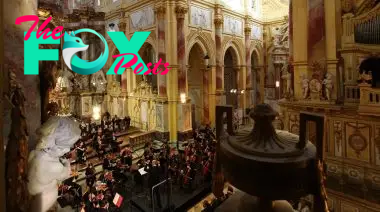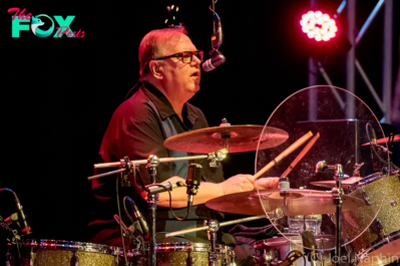Entertainment
Gerd Schaller drives the Bruckner Eighth Categorical at Ebrach – Seen and Heard Worldwide
 Germany Ebracher Musiksommer – Gigantisch: Philharmonie Festiva / Gerd Schaller (conductor). Ebrach Abbey, Germany. 14.7.2024. (KW)
Germany Ebracher Musiksommer – Gigantisch: Philharmonie Festiva / Gerd Schaller (conductor). Ebrach Abbey, Germany. 14.7.2024. (KW)

Bruckner – Symphony No.8 (1890)
On the tumultuous shut of this quick and passionate efficiency of Bruckner’s Eighth Symphony, Maestro Schaller held his arms aloft, the second frozen, a shocked and prolonged silence, and I stated to myself, ‘What the blazes was that?’ – or phrases to that impact! It was a sense as if one had stood upon the station platform ready for the circuitous gradual practice to heaven, and all of the sudden, unexpectedly, a mighty categorical had thundered by. It was typically a really loud efficiency, and a efficiency that was over in not rather more than an hour and ten minutes, the primary motion took simply over 13 minutes, the Adagio considerably lower than 21 minutes – faster than in all probability all these you could find listed on John Berky’s discography at abruckner.com.
It was such a shock partly as a result of we have been right here with the orchestra in an ecclesiastical house, the huge Abbey at Ebrach, the place you anticipate the quiet and the meditative – and a measured slowness. We all know our Bruckner’s Eighth, a monumental and deeply profound work and, as Robert Simpson tells us, Bruckner teaches us endurance. However proper from the beginning, the opening theme carried a way of pressing and anxious aspiration, every phrase formed to surge emphatically in direction of its momentary vacation spot, the next phrase impatiently carrying the vitality ahead. The short tempo helped make the transition to the second theme completely seamless, and the track that this Gesangsperiode sang was not for a second a matter of lyrical rest, however extra certainly one of heartfelt assertiveness and gathering momentum.
The efficiency of the primary motion swept you up with hardly a second to replicate on the grim and violent crises of its climaxes, the entire motion displaying a unity of objective, an awe-inspiring grip on the lengthy line of the musical argument. On the finish, the repeated phrases of the closing ‘loss of life watch’ have been completely metronomic, a tempo, and no diminuendo. Abruptly it was over! After this, the Scherzo gave the impression to be filled with joyful exuberance, the thumping timpani as thrilling to observe as to listen to, the stirring, climbing bass line in cellos and double basses within the crescendo (bars 11-18) in the midst of the exposition of the theme, delivered to the fore. The trio was by no means in peril of pre-empting the gradual motion correct, and if it was a dream, then it was a songful dream of triumphant vitality.
Taking part in the large Adagio at a ‘flowing’ tempo actually achieved, as within the first motion, a way of the lengthy line and the unity of the motion. The arpeggio motive of the opening theme, at bar 15, surged upon us all of the sudden at an elevated tempo, giving added pleasure and route, the vacation spot in the end to be revealed as the identical motive forming the principle climax. All of the landmark moments of the motion have been, after all, in place, however not as we’re used to listening to them. The ultra-slow religioso was nowhere to be heard; it appeared extra an agitated and infrequently loud celebration of Bruckner’s wonderful melodies and sounds. On the best way as much as the climax the allusions to the heroic Siegfried motive rang out imPetuously and Schaller remained true to his interpretation even within the closing pages of the Adagio which, relatively just like the shut of the primary motion, made no concession to sentimentality, no unmarked decelerando or diminuendo, the music a tempo and sounding relatively as if it have been a mild finish to a serenade.
Tempo for the Finale was not so removed from that adopted by many different conductors – on the short aspect however not unprecedented. Even so, the motion rushed by, fraught with drama and occasion, the brass resplendent, the timpani dramatic. Schaller was in a position to make sure that the route and coherence of the music was by no means unsure, and the magnificent coda was quick and really thrilling, the Scherzo theme ringing out, now gloriously triumphant, above the sonorous superimposition of the symphony’s themes. The general impact was fairly shattering.
Little doubt, in case you are wedded to performances of the stature of Karajan, Jochum, Giulini, Wand et al, Schaller’s tackle this music won’t be to your style. And certainly, 14 years earlier, judging from his recording of the 1888 ‘variant’ of the primary model, Schaller’s method was rather more expansive than it’s now, that recorded efficiency lasting about 13 minutes longer than this current efficiency. However how refreshing it’s to listen to an interpretation of the symphony so completely different from that which we’re used to listening to, gigantic and monumental certainly, however shorn of a lot of the paranormal trappings, the gradual and infrequently relatively heavy profundity that’s introduced by these different well-known interpretations; as a substitute we heard a symphony of turbulent pleasure, passionate vitality all through, with a robust sense of line and of the over-arching type, celebrating the complexity and the liveliness, the coherence and the sheer glory of the sound of Bruckner’s music. And naturally, the Philharmonie Festiva performed splendidly as they at all times do, a efficiency filled with dedication and panache.
The version was unspecified, and because the authentic manuscripts at the moment are all accessible to peruse on-line, it’s doable that the conductor made his personal version as he has for some performances of different Bruckner symphonies. Nevertheless, I heard nothing to establish it as being aside from the Nowak version. The efficiency was recorded by BR Klassik and shall be issued on CD by Hänssler Profil.
Ken Ward
-

 Entertainment20m ago
Entertainment20m ago3 Completely different Kinds of TV Appearing Roles
-

 Entertainment40m ago
Entertainment40m agoMeet Ava, the Golden Tiger Cub in Thailand Set to Be the Next Cute Viral Sensation
-

 Entertainment41m ago
Entertainment41m agoBest Tom Hardy Movies that Are Must-Watch
-

 Entertainment11h ago
Entertainment11h agoBeyonce to Headline Halftime Show During NFL Christmas Game
-

 Entertainment13h ago
Entertainment13h agoDid You Correctly Answer This Poughkeepsie Related Jeopardy Question?
-

 Entertainment17h ago
Entertainment17h agoWhat to Know About Denzel Washington’s Gladiator II Character
-

 Entertainment18h ago
Entertainment18h agoChanges Made in New York to “Men Working” Construction Signs
-

 Entertainment1d ago
Entertainment1d agoRemembering Song Jae-rim: A Look at His Best Movies and K-Drama Performances



























